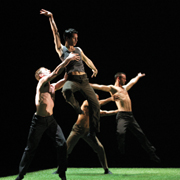
Jack Anderson
Scapino Ballet
 |
| "The Green" from The Scapino Ballet. Photo by Hans Gerritsen. |
Scapino Ballet: Adult Entertainment
Scapino Ballet Rotterdam
Joyce Theater, 175 Eighth Avenue at 19th Street, Chelsea
April 22-27, 2008
Tuesday and Wednesday at 7:30 p.m.,
Thursday and Friday at 8 p.m., Saturday at 2 and 8 p.m.,
Sunday at 2p.m., $38
Tickets: (212) 242-0800 or www.joyce.org
Reviewed by Jack Anderson, April 24, 2008
No doubt about it, Scapino Ballet Rotterdam has grown up. Founded in 1945, Scapino originally specialized in children's programs. But, in time, the troupe transformed itself and on its previous, but infrequent, New York visits, it brought us adult fare. Now, in its first engagement here since 1994, it proved to be an invigorating company with serious, but not lugubrious, ballets that received high-voltage performances. This was ballet as truly adult entertainment.
Two works were by Ed Wubbe, the current artistic director; two others, by Marco Goecke, a resident choreographer. Both men seem unafraid to try out ideas, sometimes unusual ones.
Seven men met in repeated encounters on a green floor cloth in "The Green," which Wubbe set to the opening chorus of Bach's "St. John Passion." As the magnificent music swelled, the men hurtled forward or slid across the space or scuttled on hands and knees, sometimes as a team, sometimes splitting up to become combatants. Their recklessness made them riveting to behold on this turf which symbolically could represent either a green meadow or a green gambling table where games are played for high stakes by players gathered in unpredictable rivalries and allegiances.
All of Scapino's ballets were to vocal music. But the choreographers never appeared to interpret lyrics literally. Bach's chorus asks Jesus to show in His Passion how He will rise victorious. But Wubbe ignored theology, giving us the sheer physical fact of struggle.
Wubbe's "De Bruiden (The Brides)" was for nine women, all of them looking as agitated as the men of "The Green" as they trembled and hopped to "Les Noces," Stravinsky's cantata about a peasant wedding, and Pamela Homoet's costumes recalled peasant dresses. But this wedding or, more likely, this preparation for one, involved no visible men, and that may have been part of Wubbe's point.
Bronislava Nijinska, who choreographed the original (and still unsurpassed) version of "Les Noces," has said that one thing she took into account when she created her ballet was the fact that many peasant weddings were arranged marriages; bride and groom may not even have met each other before. Wubbe appears to acknowledge this by having the women occasionally stride downstage and stare at the audience, as if they were prospective brides in a marriage market disconcertingly akin to a slave market in which bodies are up for sale. We in the audience, men and women alike, thereby assume the roles of bidders. Unfortunately, the Joyce's often tinny sound system made Stravinsky's clamorous, yet rich, score seem unnecessarily strident.
Goecke's ballets suggested he enjoys outrageousness which, provided he doesn't wallow in excess, is certainly preferable to the choreographic timidity t hat afflicts some American ballet companies. "Äffi," a solo for Tadayoshi Kokeguchi to Johnny Cash songs, found the dancer crouching and twitching, often with his back to the audience, his concentration making the solo's protracted anxiety compelling.
Goecke may be fascinated by keeping dancers' backs to spectators, for a whole ensemble often did that in "Der Rest ist Schweigen (The Rest Is Silence)." They also scrambled, jumped in crooked leaps, and ran in place. They let their costumes shed leaves, they blew enormous booming horns, and sometimes gurgled and squeaked. Yet the recorded music was a set of sweet songs by Stephen Foster which, given the tumultuous action, would have sounded incongruous in this context even without the gurgles.
It was occasionally hard to resist the impression that Goecke was being odd just for the heck of it. But considering the way dancers kept turning away from the audience to face an upstage void and the air of desperation that hovered about their antics, it was possible to wonder if the ballet depicted frantic attempts both to confront and to evade the facts of human frailty and mortality. Whatever his intentions, Goecke gave us surprises.
Scapino itself was a surprise, a welcome one.
(But one more thing should be said. Scapino quoted favorable reviews of its works as part of the Playbill program notes for each ballet, something other companies should avoid imitating, for it smacks of boasting. Dances are dances: let audiences make of them what they will.)
| museums | NYTW mail | recordings | coupons | publications | classified |
